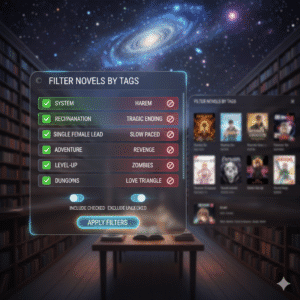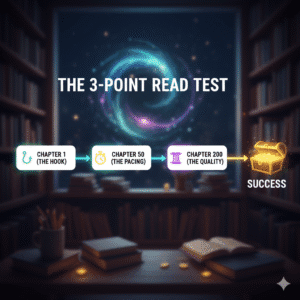The webnovel world is huge. It’s like a massive ocean with thousands of stories being published every day. Finding the right story—the one that keeps you up all night—can feel impossible. How many times have you read 100 chapters only to drop the novel because the plot went sideways?
You’re not alone. The sheer number of choices can lead to “reader burnout.”
But don’t worry. This ultimate webnovel reading guide is here to help. We’re going to give you three powerful tools to cut through the noise. These tools will help you find that perfect read every single time. It’s time to stop wasting chapters and start enjoying your reading journey.
Tool 1: Mastering the Art of Tag Filtering
Tags are your first and best defense against a bad read. Think of tags as instant summaries. They are the keywords the author and platform use to tell you exactly what the book is about. Learning how to master filtering novels by tags is the most important skill you can develop.
The Inclusion Tags: What You Want
First, focus on the tags that tell you what you want. These are the tags that define the protagonist’s starting point or main gimmick.
- The Power Gimmicks: Look for tags like
System,Reincarnation, orTransmigration. These tell you the hero starts with a cheat. You know the progression will be fast and satisfying. - The Setting/Vibe: Tags like
Academy,Dungeons, orPost-Apocalypticdefine the scenery. If you love stories about attending a magic school, theAcademytag is non-negotiable. - The Relationship Structure: This is vital. Tags like
Single Female LeadorNo Romanceimmediately tell you what the love life will be like. If you hate complicated love triangles, using these tags will save you hours of frustration.
The Exclusion Tags: What You Hate
The real power of filtering novels by tags comes from knowing what to exclude. This is how you avoid your personal “deal-breakers.”
- The Emotional Triggers: Many readers have topics they simply cannot read. Tags like
Tragic Ending,NTR (Netorare), or themes of deep abuse are things you must actively filter out if they bother you. Ignoring these tags is the fastest way to ruin a great story experience. - The Pacing Trap: Tags like
Slow PacedorSlice of Lifeare warnings. If you crave non-stop action and fighting, these novels will bore you quickly. Use the filter to ensure the pace matches your mood.
Using both inclusion and exclusion tags is the most effective way to curate your reading list and instantly improve reading experience.

Tool 2: Identifying Plot Styles and Avoiding Pitfalls
Tags tell you the ingredients, but plot styles tell you the recipe. Plot styles are the deeper narrative structures that define the hero’s journey. Knowing these helps you predict where the story is going and is key to avoiding bad webnovel tropes.
Style 1: The Face-Slapping/Revenge Trope
- The Setup: The hero is humiliated, often by a rich rival or a former fiancée. They are mocked as “trash.”
- The Journey: They get a cheat power, train, and return to publicly humiliate everyone who wronged them. This is the “face-slapping” moment.
- Why You Read It: You want instant gratification and clear justice.
- The Pitfall: If the author drags out the revenge for too long, or the hero keeps getting humiliated, the trope fails. It becomes repetitive. If you are looking for instant wins, and the revenge is too slow, that’s when you know to drop it.
Style 2: The Studio Building/Farming Trope
- The Setup: The hero finds a magical space, a unique resource, or inherits a rundown sect.
- The Journey: The plot focuses on managing logistics, gathering resources, crafting, and growing their territory. The fighting is secondary to the management.
- Why You Read It: You enjoy strategy, politics, and watching something grow from nothing.
- The Pitfall: The writing can get bogged down in technical details (like pricing herbs or managing workers). If you are bored by the business side of things, this style isn’t for you.
Style 3: The Exploration/Mystery Trope
- The Setup: The protagonist usually has an ancient secret or foreknowledge of the world’s deep past.
- The Journey: The focus is on uncovering hidden lore, ancient wars, and cosmic truths. The hero’s greatest asset is their knowledge, not just their fighting skill.
- Why You Read It: You love complex world-building and lore.
- The Pitfall: Sometimes the mystery gets too big. The author introduces so many questions that they can’t answer them all. This leads to confusing endings or plot holes. It’s one of the main ways authors fail at avoiding bad webnovel tropes.
Style 4: The Comedy/Parody Trope
- The Setup: The hero is often ridiculously overpowered but clumsy, awkward, or just obsessed with a mundane goal (like eating snacks).
- The Journey: The plot pokes fun at the genre itself. Every serious situation is turned into a joke.
- Why You Read It: You need a break from serious, dark themes.
- The Pitfall: If the humor doesn’t land, the story falls flat. Humor is very subjective, so you have to read a few chapters to see if the author’s style matches yours.
Understanding these styles helps you filter novels before you even read the description. You can instantly tell if the novel’s core structure will appeal to you. For more background on these narrative patterns, you can check out the TV Tropes Website, which explains how literary patterns work across all media.
Tool 3: Advanced Strategies for the Dedicated Reader
Once you’ve mastered tags and plot styles, it’s time to refine your search with advanced binge-reading strategies. These methods are essential for managing the sheer volume of chapters in the webnovel world.
The “Three-Point Read” Test
Don’t just read the first three chapters. That’s a mistake. The author only focuses on the hook there. To truly test a novel before committing, read three specific points:
- Chapter 1: The Hook. Does the premise grab you?
- Chapter 50: The Pacing. Is the author capable of moving the plot forward after the setup?
- Chapter 200 (or later): The Writing Quality. Has the author maintained consistency? Is the tension still there?
If you like all three points, you’ve found a solid novel. This method is the ultimate way to quickly and effectively improve reading experience.
Efficient Review Mining
The review section is a goldmine, but only if you know how to mine it.
- Ignore the Extremes: Skip the 1-star reviews (usually just angry people) and the 5-star reviews (usually biased fans).
- Focus on the Middle: Read the 3-star and 4-star reviews. These are the most honest. They will tell you, “It was great, but the plot dragged after chapter 800,” or “The world-building is amazing, but the romance is terrible.” This information is priceless for avoiding bad webnovel tropes.
- Use the Search: Look for specific keywords within the review section, like “pacing,” “ending,” or “romance.”
The Author’s History Check
If you find a book you love, check out the author’s previous works. Authors often recycle their best plot styles and narrative tricks. If you like one of their novels, chances are you’ll like another. However, be cautious: sometimes authors repeat too much, so check for signs of stagnation.
Update Schedule and Completion Status
For long novels, a consistent update schedule is non-negotiable. An author who updates regularly shows commitment, which improves your overall reading experience. Always check the completion status. It’s a great binge-reading strategies to only start reading novels that are already finished, so you don’t have to wait for new chapters.

Conclusion: Your Journey Starts Now
The search for the perfect story is a fun part of the hobby. You now have the tools to be a master filter. You have learned how to use tags, identify common plot styles, and employ advanced binge-reading strategies to save time and money.
Remember:
- Master filtering novels by tags to instantly find what you want and avoid what you don’t.
- Use your knowledge of webnovel tropes to predict the plot’s path and prevent disappointment.
The goal is to maximize your enjoyment. Now, take these skills and head over to our catalog. It’s time to test your new webnovel reading guide and find the gem that’s waiting for you!
For even more specific recommendations and to see these strategies in action, check out our popular article on Top 10 Overpowered Characters in Chinese Fantasy
